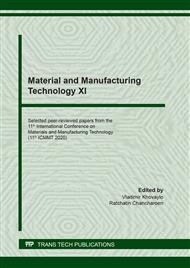[1]
Kim H, Macosko C W. Processing-property relationships of polycarbonate/graphene composites[J]. Polymer, 2009, 50(15): 3797-3809.
DOI: 10.1016/j.polymer.2009.05.038
Google Scholar
[2]
Yao YL, et al. Infusing High-density Polyethylene with Graphene-Zinc Oxide to Produce Antibacterial Nanocomposites with Improved Properties [J]. Chinese Journal of Polymer Science, 2020, doi.org/10.1007/s10118-020-2392-z.
Google Scholar
[3]
Tian W, Cheng D, Wang S, et al. Phytic acid modified manganese dioxide/graphene composite aerogel as high-performance electrode materials for supercapacitors[J]. Applied Surface Science, 2019, 495: 143589.
DOI: 10.1016/j.apsusc.2019.143589
Google Scholar
[4]
Zhang Q, Yang P, Shen J, et al. Graphene-Amplified Photoelectric Response of CdS Nanoparticles for Cu2+ Sensor[J]. Journal of nanoscience and nanotechnology, 2019, 19(12): 7871-7878.
DOI: 10.1166/jnn.2019.17179
Google Scholar
[5]
Zhang R, Wang Y, Ma D, et al. Effects of ultrasonication duration and graphene oxide and nano-zinc oxide contents on the properties of polyvinyl alcohol nanocomposites[J]. Ultrasonics sonochemistry, 2019, 59: 104731.
DOI: 10.1016/j.ultsonch.2019.104731
Google Scholar
[6]
Labet M, Thielemans W. Synthesis of polycaprolactone: a review[J]. Chemical Society Reviews, 2009, 38(12): 484-504.
Google Scholar
[7]
Zhou J, Yang Y, Detsch R, et al. Iron surface functionalization system-Iron oxide nanostructured arrays with polycaprolactone coatings: Biodegradation, cytocompatibility, and drug release behavior[J]. Applied Surface Science, 2019, 492: 669-682.
DOI: 10.1016/j.apsusc.2019.06.060
Google Scholar
[8]
Deliormanlı A M, Atmaca H. Prechondrogenic ATDC5 cell response to graphene/multi-walled carbon nanotube-containing porous polycaprolactone biocomposite scaffolds[J]. International Journal of Polymeric Materials and Polymeric Biomaterials, 2019, 68(18): 1154-1166.
DOI: 10.1080/00914037.2018.1539984
Google Scholar
[9]
Chen X, Zhang Q, Hou D, et al. Fabrication and characterization of novel antibacterial silk sutures with different braiding parameters[J]. Journal of Natural Fibers, 2019, 16(6): 866-876.
DOI: 10.1080/15440478.2018.1441087
Google Scholar
[10]
Jost V. Packaging related properties of commercially available biopolymers–An overview of the status quo[J]. Express Polymer Letters, 2018, 12(5): 429-435.
DOI: 10.3144/expresspolymlett.2018.36
Google Scholar
[11]
Phromma W, Magaraphan R. Fabrication of admicelled natural rubber by polycaprolactone for toughening poly (lactic acid)[J]. Journal of Polymers and the Environment, 2018, 26(6): 2268-2280.
DOI: 10.1007/s10924-017-1121-3
Google Scholar
[12]
Tsou, C H, Yao WH, et al. Antibacterial property and cytotoxicity of a poly(lactic acid)/nanosilver-doped multiwall carbon nanotube nanocomposite[J]. Polymers 2017, 9, 100−113.
DOI: 10.3390/polym9030100
Google Scholar
[13]
Zhang G, Wang P, Zhang X, et al. The preparation of PCL/MSO/SiO2 hierarchical superhydrophobic mats for oil-water separation by one-step method[J]. European Polymer Journal, 2019, 116: 386-393.
DOI: 10.1016/j.eurpolymj.2019.04.011
Google Scholar
[14]
Tsou C H, Wu, C. S et al. Rendering polypropylene biocomposites antibacterial through modification with oyster shell powder[J]. Polymer 2019, 160, 265−271.
DOI: 10.1016/j.polymer.2018.11.048
Google Scholar
[15]
Tsou, C. H., Lee, H. T., Hung, W. S., Wang, C. C., Shu, C. C., Suen, M. C., & De Guzman, M.. Synthesis and properties of antibacterial polyurethane with novel Bis(3-pyridinemethanol) silver chain extender[J]. Polymer, 2016, 85, 96–105.
DOI: 10.1016/j.polymer.2016.01.042
Google Scholar
[16]
Tsou, C. H., Yao, W. H., Wu, C. S., Tsou, C. Y., Hung, W. S., Chen, J. C., … De Guzman, M. R. (2019). Preparation and characterization of renewable composites from Polylactide and Rice husk for 3D printing applications[J]. Journal of Polymer Research, 26(9).
DOI: 10.1007/s10965-019-1882-6
Google Scholar


